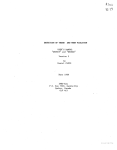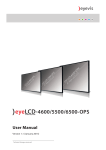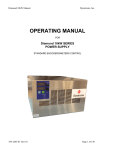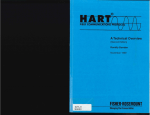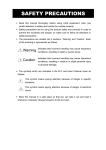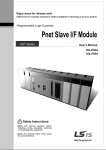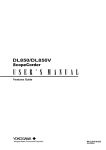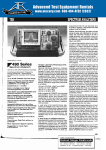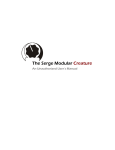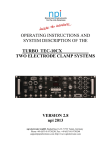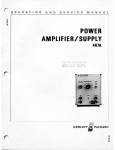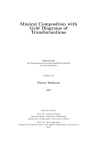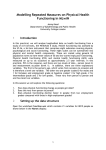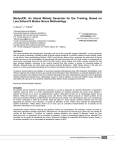Download LADER ANLOG
Transcript
United States Patent [19] ['11] 4,283,984 Faulkner [45] Aug. 18, 1981 [54] CAPTURE SYSTEM FOR AN ELECTRONIC MUSICAL INSTRUMENT [76] Inventor: Alfred H. Faulkner, 1324 Portesuello Ave., Santa Barbara, Calif. 93105 Primary Examiner-J. V. Truhe Assistant Examiner—Forester W. Isen [57] ABSTRACT A microcomputer based synthesizer having a digital keyboard, digital envelope generators, voltage con [21] Appl. No.: 134,250 Int. Cl.3 ............................................. .. GIOH 1/02 trolled ampli?ers and ?lters, and numerous potentiome ter type presets is disclosed. The presets are scanned by the microcomputer, converted to digital form, stored [52] US. Cl. .............................. .. 84/124; 84/ 1.03 for recall on demand in a non-volatile memory, con [58] Field of Search .................... .. 84/ 1.24, 1.03, 1.01, verted to exponential form by use of a look-up table [22] Filed: [51] Mar. 26, 1980 84/345 [56] References Cited U.S. PATENT DOCUMENTS 3,986,423 10/1976 4,185,531 l/l980 4,227,432 4,244,259 10/1980 1/1981 Rossum . . . . . . . . .. . . . . . . . . . . .. 84/1.0l Oberheim et al. . when required, and output to clamp-and-hold circuits associated with each voltage controlled circuit. Each preset sample and hold operation is followed by a scan of the keyboard to minimize the impact of the capture system on the keyboard scanning rate. 84/1.l9 Bagus ........... .. 84/1.0l Koike .................................. .. 84/l.0l I 6 Claims, 13 Drawing Figures POO-P07 P24-P27 KEYBOARD COMPUTER I00 5m LADER 118 AN-MLOG DECODER ANLOG TO OTHER D1SCRETES US. Patent Aug. 18, 1981 Sheet 2 of7 T TO XTALI —-J_ REsET U‘) 2o| 4,283,984 ' XTAL 2 -—T < w: ~-& 2 T 8j < ALE 2o2\ m i i E E I 1m 01 U) FIG. lb _ ‘1 ENVELOPE COMPUTER ) in 200 g r 203/ 8 _ PIO'IT :> E n: WR g 204 ' 2053 207 I P20-27 :> < \~ 5 ANALOG -' * (D MULTIPL'R g V a: . < To To J OTI-EIR OTHER NOTE GENERATORS VCFS r- — j : 1 |30| — — ~ — — - - - DUAL - _ - - MULTIPL'R ['0 LE vco - _ _ _ _ _ _ _ _ _ _ NOTE GENERATOR I I RES. k’ NET ,30? V J308 V ,309 1 , 8H 2P Rom 4H 4P ‘ I I I I | I ZHBPIH I Rom“ [6P SH I I I I I I I T 4 ale I L‘ 3'0’ 312 ll Int-N315 :11’ - MW_ I I_ _ V I J _ COUNTER '> ~ vco _ M306 ,l. 3 SW1, REG *sjrQRE 8 6H 5HROM 3H 83H 1 303/ BIL I I I I I I I _ 305 3°" | —L — COUNTER I _ — ,30: __ _ _ \am _ _ _ _ _ _ _ _ _ _ _ _ _ _ _ _ _ _ _ _ _ _ _ _ _ _ _ T." __ _\ A NALOG MULTIPL'R AUDIO OUTPUT _I U.S. Patent Aug. 18, 1981 I START I Sheet 3 of 7 4,283,984 ._____.__1 FIG.2O COMPUTE NEW BLOCK BI STARTING ADDRESS BIS — & STORE IN R37 .___________I SET FO=1. TRANSFER B,A,D1,D2,R INPUT BLOCK SELECT & MODE CONTROL SIGNALS & STORE W RSF TO ENVELOPE COMPUTER. OUTPUT R26 TO R102. 83 BI7 < HAS BLOCK SE L ECT C HAN GED '? >YES IS CPN>16H7 B27 .1 NO NO may sTORE DATA IN INPUT DATA FROM CAPTURE MEMORY s. sToRE IN Rs I 87 INPUT DATA FROM DISCRETE REGISTER INPUT DATA FROM SLIDE CONTROLS _, B20 CAPTURE MEMORY __________.1 _ F sET P23=0 I B28 58 "0 Is CPN>17 YES ' 8? NO IS CPN>16H? B22 _ NO coNvERT LINEAR INPUT ' TO EXPONENTIAL OUTPUT 1 B29 HAS B‘A'DLDZ OR R CHANGED? OUTPUT DATA TO LADDER L BIO ‘- * ENABLE IvIuLTIPLExER OUTPUT F__—_J B23_ OUTPUT DATA TO DIscRETE REGISTER SET F0=O.' I 4 INPUT R202. B24» INCREMENT TIME IF TF=1. sET P21=1. SET Ro-Ra2=o. sTART TIMER WAIT FOR |NT=1. 854 F ENABLE INTERRUPT. \ SET F0=0. SET Ro=3aR INHIBIT MULTIPLExER OUTPUT BM YES 35; g'g'gl'm YES IS CPNZ18H'? 525 l SET CPN=O I INOREMENT CPN B26 “530 ' US. Patent Aug. 18,1981 Sheet4 of7 4,283,984 @ US. Patent Aug. 18, 1981 4,283,984 Sheet 5 of 7 I Cl3 / I START ) PRESET RC-Ra FOR vULNERABILITY TEST. INITIALIZE INTERRUPT & Cl HANDSHAKE SIGNALS TO FI SET ACC= LAST CONTACT "B" STATUS 3 ,, KEYBOARD COMPUTER. o SET RF.R11&FI202=0. ‘3'4 __-<“ Is “BX-1 STATUS=O7 > Y ES 7 cIs MOVE .. B .. CONTACT STATU FROM HF To R10‘ COMPARE TE OF PRESENT 8 /C2 NG WITH PREVIOUS MAX. IF GREATER I STORE IN R3 AND PLACE MASK OF NG IN R4 INPUT PRESENT STATUS & STORE IN RE C3 |STO=1? YES ‘ | "0 c 6 POINT Ro TO TE OF NEXT NG _ ACKNOWLEDGE INTERRUPT cIo __ BY KEYBOARD COMPUTER. cl.’ INPUT TRANSFER INSTRUCHON c" ARE TESTS COMPLETE? IS BIT 5=1? YES CIB‘. No 03 OUTPUT MASK 0F vULNERABLE NG I , DECREMENT A,D1,D2,&FI EgEggTigxngpgg'a‘? COUNTERS, RECYCLE ANY L K ' COUNTERS REACHING o & SET 1 IN CORRESPOND- 'F Ass’ SET R7IMSNI=A AND SET m4=21H~ R7 ING&BIT SETPOSITION 0 IN OTHER OF 'FAND A>5ISET SETR14=A_6' H7IMSNI=5 CI2 " F | G- BIT POSITIONS OF R7 @ POINT Ro TO R18. SET1 IN CORRESPONDING INCREMENT TRANSIENT ' c5 C37 \_ BIT POSITION OF R6. CALL EGS. EXPONENT OF NOTE IN PROCESS. SET LNExP TABLE ADDRESS =18H. I @ I POINT Ro TO R38. SET1 IN CORRESPONDING 69 / BIT POSITION OF R6. C119 CALL EGS. ______I \ DOUBLE RIGHT SHIFT R3 BY R2 PLACES INTO EA REGISTER. C38 -- SET ENVELOPE STATUS OF NOTE IN PROCESS=0 WHEN EA=0. @ CONVERT PITCH OF NOTE IN PROCESS TO DR DATA USING TABLE LOOK-UP & STORE IN DR COUNTER @ US. Patent Aug. 18, 1981 Sheet 6 of7 4,283,984 #8 OZ AH; US. Patent Aug. 18, 1981 Sheet 7 of7 4,283,984 2P4 20! ALE 580 'm -_ .._-_ E I VCF-Z l >81 Q I I g '9 8 ENVELOPE g5 ‘1 COMPUTER < ||\| _ \ I | Iu: 210 u m 207A '65 :> g0 E._> lg j POO-O7 W ‘\ ' (,5 # I _ 3% II Eg <5 ‘\ 204A ' -- I 206A 205A -- CLAMP I I I I aHOLD - - - -- CKTS. : I Ci" FIG. 6 C40 ARE II 2II CONTACTS CLOSED? - 9 25 NO cm <15 BRANCH POINTER \_YES SET TO ATTACK? / N0 ' 6/26 935 EXECUTE ATT’ACK 036 I EXECUTE DECAY 2 I L——-I—'_"1 | I ExEcuTE DECAYI 1 I EXECUTE RELEASE I I I C33 1 I 386 I 1 4,283,984 2 One of the principal objects of the invention is to provide a simple and economical capture system for an electronic musical instrument‘ that can be easily imple mented in a microcomputer that also services a digital CAPTURE SYSTEM FOR AN ELECTRONIC MUSICAL INSTRUMENT 5 type keyboard. BACKGROUND OF THE INVENTION Another object of the invention is to minimize the Capture systems, or combination actions, were intro amount of memory required, both external to and duced ages ago in pipe organs to enable the organist to within the microcomputer. ' store a number of different combinations of stop settings Still another object of the invention is to provide a for ready recall during a performance. The ?rst of such capture system which allows data to be stored in a systems were entirely mechanical, but these later gave linear form and converted to a non-linear form before way to electromagnetic operation with mechanical latches providing the memory. Present day electronic instruments pose a similar problem to the player by providing a larger array of controls than the player can being transferred to the utilization circuits, so as to minimize the required memory word length. Other objects of the invention will be apparent from the following description and the accompanying draw ings. While illustrative embodiments of the invention handle easily during a performance. The problem is compounded by the fact that these controls are mainly potentiometer type, rather than the simple on-or-off stop switches provided in pipe organs. are shown in the drawings and will be described in detail herein, the invention is susceptible of embodiment in many different forms and it should be understood that the present disclosure is to be considered as an example of the principles of the invention and is not intended to limit the invention to the embodiments illustrated. One of the commercial synthesizers presently on the market provides a quadruple set of controls with a gang selector switch to allow instant selection of any one of the four set-ups. Besides being very expensive, this ap proach also takes a great deal of panel space, making the instrument very bulky. 25 SUMMARY OF THE INVENTION The embodiment chosen to illustrate the invention is a polyphonic synthesizer employing a digital type key board where the playing keys are scanned repetitively by a microcomputer to detect changes in key states and idle note generators are assigned to playing keys in response to their depression. There are 25 preset con trols, most of which are potentiometer type controls. The voltage control circuits that effect the desired tonal responses are each provided with a simple clamp-and hold circuit to enable them to be controlled in a dy namic fashion by the microcomputer. Between each scan of the keyboard, the microcom puter processes a different one of the presets. Normally a preset control is selected by an input selector switch, commonly called an analog multiplexer; converted to a 4 bit digital word, representing 16 equally spaced posi tions of the potentiometer slider, in the microcomputer; converted to an 8 bit digital word in accordance with a 45 BRIEF DESCRIPTION OF THE DRAWINGS FIGS. 1a and 1b, when placedside by side, form a unitary functional block diagram of one preferred em bodiment of a digital polyphonic music synthesizer using the invention; FIGS. 20 and 2b, when placed side by side, form a unitary flow chart of the program used in one mi crocomputer, shown in FIG. 1a, that services the key board and voice controls; FIGS. 20 and 2d, are ?ow charts of subroutines used in the above keyboard microcomputer; FIG. 3 is a flow chart of the program used in a second microcomputer, shown in FIG. 1b, that generates ?ve envelopes simultaneously; and FIGS. 40, 4b, 4c and 4d, are ?ow charts of subrou tines used in the above envelope computer. FIG. 5, is a block diagram showing a modi?cation of the system shown in FIGS. 10 and 1b to provide for simultaneous outputs of envelopes in both nominal am plitude and pitch scaled amplitude forms. FIG. 6, is a ?ow chart showing a modi?cation of the desired non-linear scale using a look-up table, when envelope computer program depicted in FIG. 3. required; and output through an output selector switch to the corresponding clamp-and-hold circuit. DESCRIPTION OF THE PREFERRED EMBODIMENTS One or more CMOS type memories are provided and are made accessible to the microcomputer. They are I. Organization of the Music Synthesizer digital words representing the slider positions of each As shown in FIGS. 1a and 1b, two microcomputers (Intel 8048 or 8748) are provided. The keyboard com puter 100 interfaces the keyboard 150; capture memory control switches 155 and 156; voice controls 153, 154, 157; intercom registers 102, 202 and 203, capture memo ries 103404; ?ve note generators, such as 300, through preset control are then stored in sequence in the mem ory as they continue to be processed in the normal way. When the player wishes to recall a previously stored set-up, he selects the desired memory block and oper ates the mode switch to the read capture memory posi tion. The 4 bit digital words stored previously are read The envelope computer 200 interfaces intercom reg isters 102, 202 and 203; and ?ve voltage controlled ?lters (VCFs), such as 350, 370, 380, through a D/A ladder network 206 and analog multiplexer 205. effectively non-volatile by the provision of battery back-up power. When the player wishes to store a set up for future recall, he selects a block of memory in which he wants the set-up stored, then operates a mode switch to the store position momentarily. The 4 bit 55 decoder 105; clamp-and-hold circuits 111; and discrete registers 109 and 110. Since the 8048 and 8748 microcomputers are standard out sequentially and processed in exactly the same way devices that are well known in the art and are fully as the corresponding words derived from the presets are processed normally. This action continues as long as 65 described in the MCS-48 User’s Manual, published by Intel Corp., their architecture and circuit operation are the mode switch is left in the read capture memory not described herein. The two computers 100 and 200 position to maintain the clamp-and-hold circuits at the may each be provided with its own 6 mhz crystal, as desired setting in a dynamic manner. 3 4,283,984 shown, or they may be operated in synchronizm from a 4 A memory map showing the allocation of the 64 common source. registers (0-3F in hexadecimal notation) is shown in ' The principal function of the keyboard computer is to scan the keyboard contacts about once every millisec Table I. An “x” in any bit column signi?es that either a 0 or a 1 may be stored in that bit position, while a “0” signi?es an unused bit that is set to 0 during initializa ond, detect any changes in contact states, measure the travel time of a key being depressed, assign an idle envelope generator to a key when it has been fully tlon. TABLE I operated, and transmit pitch and key velocity (touch response) information to the envelope computer. Pitch MAP OF KEYBOARD COMPUTER DATA MEMORY BITS REG 76543210 FUNCTION information is also transmitted to the appropriate note generator, such as 300. An auxiliary function, performed at a much slower rate, is to scan the voice, or preset, controls; convert each one to digital form; convert the digital value to a new value, when required, using a look-up table; and 5 0 1 xxxxxxxx xxxxxxxx Indirect addressing-general use Indirect addressing-keyboard status 2 3 OOOOXXXX Identi?er-current keyboard group 00O000xx Identi?er-current bit of keyboard group 4 0000xxxx Mask for current bit of keyboard group then output the original, or new, value to a ladder net 5 xxxxxxxx General register use work 115, thence to a corresponding clamp-and-hold circuit 111 via the analog multiplexers 107-108. 6 xxxxxxxx General register use 7 xxxxxxxx Save ACC during interrupts 8-D xxxxxxxx 3 level address stack 00000000 000000Ox xxxxxxxx xxxxxxxx xxxxxxxx Spares F3 ?ag Save ACC during certain branch operations (R0’)-General indirect addressing (Rl')-General indirect addressing (R2’)-General register use E-lS If the player wishes to store the voice, or preset, l6 control setup in use; the STO mode is entered brie?y, 20 l7 by operation of switch 152, causing the digitized values 18 l9 of the voice control settings to be stored in a capture memory 103-104 at a location selected by operation of lA xxxxxxxx switches 155 and 156. Conversely, if the player wishes 1B Oxxxxxxx (R3’)-Note 1 key assignment to recall a previously stored voice control set-up; the lF Oxxxxxxx (R7')-Note 5 key assignment RCM mode is entered, by operation of switch 152, causing the digitized values of the desired settings to be read from the capture memory; converted by the look up table, if necessary, and output to the clamp-and-hold 20 xxxxxxxx 24 25 26 xxxxxxxx OOOxxxxx OOOXXXXX circuits. Some of the voice controls 157 are used to vary the 27 28 OOOxxxxx Notes l-5, Envelope status xxxxxxxx “A"&“B" contact status, keys xxxxxxxx “A"&“B” contact status, keys xxxxxxxx “A"&“B" contact status, keys xxxxxxxx “A”&“B" contact status, keys xxxxxxxx “A"&“B" contact status, keys I I 29 attack/decay parameters of the envelope generators. In 2A 2B 2C an analog system these controls would be connected directly to corresponding inputs of a set of analog type envelope generators. In the present system these inputs are digitized and stored in registers in the keyboard computer 100. Wherever a change occurs in these input 35 2D 2E values, the new values are stored internally and are also transmitted'to the envelope computer 200. Additional voice controls are provided in the form of switches, such as 153 and 154, which may be individual or combinatorial. In either case they are input as 4-bit nibbles, to conform with the 4-bit words used in the captive memory, and are output to corresponding 4-bit 45 registers, such as 109 and 110. The envelope computer 200 is dedicated to the gener ation of ?ve envelopes simultaneously. Updated digital amplitude values are output repetitively in sequence to the 16-bit ladder 206, thence via an analog multiplexer 205 to corresponding voltage controlled ?lters such as 350, 370, 380. II. Operation of the Keyboard Computer The 8048 or 8748 computer provides 1024 words by 8 bits of read-only (ROM) program memory and 64 words by 8 bits of resident data memory (RAM). All data memory locations are indirectly addressable through either of two RAM pointer registers which reside at addresses 0 and 1 of the register array. In addi tion, the ?rst 8 locations (0-7) of the array are desig nated as working registers and are directly addressable I Note l-Start time/touch response I Note S-Start time/touch response Notes l-S, “A" contact status Notes l-5, “B“ contact status F3—G3# A3-C4 C4#—E4 F4—G4# A4-C5 xxxxxxxx “A"&“B” contact status, keys C5#-E5 2F xxxxxxxx xxxxxxxx “A”&“B" contact status, keys F5—G5# “A”&“B" contact status, keys A5-C6 30 31 32 xxxxxxxx “A"&“B" contact status, keys C6#-E6 xxxxxxxx “A"&“B” contact status, keys F6-G6# xxxxxxxx "A“&“B" contact status, keys A6-C7 33 xxxxxxxx Time 34 35 36 xxxxxxxx xxxxxxxx xxxxxxxx Reserved for interrupts Reserved for interrupts Reserved for interrupts 37 xxxxxxxx Block starting address - Capture memory 38 OOOxxxxx Current parameter number 39 3A 3B 3C 3D 3E 00000000 xxxx0000 xxxx0000 xxxxOOOO xxxxOOOO xxxxOOOO Spare . B - Breakpoint A - Attack Dl - Decay l D2 - Decay 2 R - Release 3F xxxx---- Block select-capture memory --~~00xx STO & RSC - Mode control signals When power is applied to the computer 100 an inter nal reset pulse is generated to clear critical working registers, such as the program counter. After the capaci tor connected to the RESET input has charged to the threshold of an internal Schmitt trigger, the reset pulse is terminated and operation under program control commences at location 0 in the program memory. The switch instruction RAM locations 24-31 are designated as the working registers (RU-R7’) and are then directly addressable. RAM locations 8-23 contain the program program memory listing is shown in Table IX, which appears at the end of the specification, but for simplicity the operation will be described with reference to the flow chart shown in FIG. 2. A modi?ed program listing is shown in Table XI. Operation with the modi?ed 65 program is described separately in Section IV. counter stack; which is addressed by the stack pointer, during subroutine calls, as well as by pointer registers In block B1: port 21 (port 2, bit 1) is set to zero to reset the envelope computer and hold it disabled until by several instructions. By executing a register bank R0 and R1. the keyboard computer has initialized the clamp-and 5 4,283,984 6 mity obtainable in such controls leave much to be de~ hold circuits 111 (FIG, 1). Flag F0, which is set to 1 in sired. These dif?culties are overcome in the present block B1, will be set to 0 when the initialization of these circuits is completed, as described hereinafter. F3 desig ‘ embodiment of the invention by using slide controls of the linear variety and converting the linear input to an nates a ?ag, but is actually bit 0 of R16. It is set to 1 in block B1 and is reset to 0 in B13 after initialization exponential output, or other desired output shape, by operations are completed. the use ofa look-up table included in the program mem In block B2: the states of mode select switch 152 and the block selection switches 155 are stored in register ory section of the keyboard computer. In this case the input/output transfer function is changed to an expo 3F. If the block selection has changed since the last nential form by the look-up table. This programmed shaping system also allows use of commercially avail able 4-bit binary coded switches in lieu of the analog program cycle the program branches through block B15 to compute a new block starting address, which is the actual address in the capture memory at which the selected group of voice control set-up values starts. The desired capture memory chip, such as 103 or 104, is selected independently by means of switch 156. Since controls if desired. Whenever CPN is between 2 and 11H (17 in decimal notation), the program branches form B8 via B21 to B22. In block 22, the 4 bit data in R5 is used to address a linear to exponential conversion table stored in every 4th location of the program memory commencing with 303 and ending with 33F. Every 4th location is used to F0:1, the program omits B16 for the present and pro ceeds to B6 or B17, depending on the mode selected. Assume that RSC (read slide controls) has been selected for now, in which case RCM (read capture memory) is false. Since the current parameter number (CPN) stored in R38 is set=0, the program branches from B5 via B17 20 ?ll voids in the key assignment-to-pitch conversion table which starts with location 300 and ends with 33E. The converted data (8 bits) is output to register 116 and the program then returns to the original minor loop at B10. On the nineteenth pass through the minor loop gram. The three LSBs (least signi?cant bits) of 119 are connected in parallel to all of the input/output analog 25 CPN=12H, hence the program branches from B21 via B28 to B29. multiplexers, such as 112 and 107. The effective higher to B18. In block B18: register 119 is set to zero by the pro order bits of 119 are decoded by 118 to select a corre sponding one of these multiplexers. Assuming that slide control 158 is selected, its setting is applied to the input In block B29: the new data in R5 is compared with the corresponding prior data (which is practically ran dom data following initialization) stored in R3A-R3F. of comparator 114. The program now implements a If the data is unchanged the program returns to the successive approximation D/A conversion routine, original minor loop at B11, otherwise it proceeds to using register 116 and ladder 115 to generate the trial B30. In block B30: the old data in R3A-R3F is replaced with the new data in R5 and flag F0 is set=0 before the values, to convert the slide control setting to a 4 bit digital value which is generated in the MSN (most sig-. ni?cant nibble) of R5. Since STO:0, the program skips B20 and goes via B7 to B8. In block B8: CPN (R38) is tested and, since it is ini tially 0, the program enters block B9 where the data in R5 is output to register 116. The ?rst two voice control parameters are the vibrato rate and vibrato depth. These parameters vary linearly with slide control posi program goes to B11. The parameters B, A, D1, D2 and R stored in R3A-R3E require some explanation since they differ from the customary ADSR parameters provided by conventional synthesizers. The A, D1 and R parameters of the present envelope generator correspond to the conventional A, D and R parameters. In lieu of a sustain mode, the present synthesizer provides a breakpoint (B) control that establishes the level at which the initial tion, hence are output without modi?cation. decay (D1) is terminated and is replaced by a second In block B10: one ofthe high order bits of register 119 decay (D2.) If the second decay is set to in?nity, then is set to 1 to enable the output analog multiplexer, such as 107, which connects to the clamp-and-hold circuit 45 the breakpoint control becomes the equivalent of the conventional sustain (S) control. The provision of two 111 for the parameter in process. Since F3 is set to 1, the decay rates permits a much more realistic piano sound program proceeds to block B12. to be achieved. In block B12: since CPN is initially 0, the program After the B, A, D1, D2 and R parameters have been branches to B26 where CPN is incremented by 1. The program then returns to B5 and repeats the above de processed, CPN==I6I-I. On the following pass the pro scribed minor loop with the following variations. gram branches from B17 to B27. In block B27: the computer 100 outputs a code on As mentioned previously, the ?rst two voice control port 2-MSN (most signi?cant nibble=bits 4-7) corre parameters are linear functions of the slide control posi sponding to the set of four discrete switches 153 and tion, hence are output to the clamp-and-hold circuits without modi?cation other than the quantization result 55 inputs data corresponding to the switch settings via port l-MSN. This data is held temporarily in R5, just as all ing from the A/D conversion. In other words, the in the other control parameters are. When B28 is reached put/output transfer function is linear in this case. The the program branches to B23. next l6 parameters are the desired amplitudes of four pulse waveforms (16’P, 8'1’, 4'1’, and 2'P); nine har monic components (SH, 1H, S3, 2H, 3H, 4H, 5H, 6H, and 8H); two ?lter frequency controls (FCl and FCZ); In block B23: the data in R5 is output as a 4 bit nibble 60 to the ?rst discrete register 109. On the next pass the status of switch 154 is transferred to the second discrete register 110 in like manner. Only two discrete registers are needed in the synthesizer described; but it should be apparent that additional switches, such as 153 and 154; with the slide control position. Although slide controls having so called logarithmic, or audio, tapers could be 65 and registers, such as 109 and 110, can readily be pro vided for simply by changing the constants in the in emloyed; their use would require digitizing to eight bits, structions that control program branching as a function rather than four, hence would double the size of the of CPN. capture memory. Furthermore, the taper and unifor and a ?lter Q, or resonance, control (FQ). These output amplitudes should vary approximately exponentially 4,283,984 7 On the 25th pass through the minor loop CPN=18H, 8 In block B31: R1 is set=28H, which is the ?rst loca tion in the group R28-R32 where the keyboard contact status is stored. R2 is set=1 to identify the current key group as F3-G3#. The 44 note keyboard contains 11 which causes the program to exit at B12 to B13. In block B13: port 21 is set: 1 to enable the envelope computer 200, registers R0~R32 are cleared to 0, and the built-in timer is started. Computer 100 then enters a 5 groups, as shown in Table I. There are two contacts per wait loop if its WT input is low. After computer 200 sets WT high; computer 100 enables its interrupt, sets key; the “A” contacts (FIG. 10) close near the begin ning of a keystroke and the “B” contacts close near the end. Hence it takes two bits to define the status of each F0=0, and sets R0=38H. The builtin timer runs contin uously and sets a timer flag, TF, when it overflows. This flag is tested in block B24, causing R33 (Time) to key. Thus a group of four keys requires eight bits of data, or a pair of nibbles, to de?ne its status. In block 32: R3 is set=0 to identify the current bit be incremented if it is true. The flag is reset automati cally when it is tested. In block B14: CPN (R38H) is set=0. The program now returns to B2 to start its major loop. F0 is invari pair (bits representing the “A” and “B” contacts of a playing key). Since the keyboard status is manipulated as data bytes in which the LSN represents the “A” contacts and the MSN represents the “B” contacts, the value 0 in R3 identi?es the current bit pair as bits 0 and 4. For masking purposes, the current bit pair is also identi?ed as a 1 in the corresponding bit position 0-3 of ably set=0 during the initial minor loop operations, hence the program branches from E4 to B16. In block B16: the ?ag F0 is set=1 and a software interrupt of the envelope computer is initiated by set ting port 20:1. During the execution of this interrupt the breakpoint parameter stored in R3A is comple R4; hence R4 is set=1. The current nibble pair is input from the keyboard by setting port 2MSN=R2 and then inputing port 1. The decoder 151 translates the four hits mented before being transmitted to the envelope com puter via register 102. The attack parameter A (R3B) is from port 2 into a 1 of 16 selection eleven of which correspond to the commoned contacts of four adjacent tions 3D0-3DF of the program memory, before being keys. The individual contacts of all of the keys are con 25 transmitted. Similarly, the D1, D2 and R parameters are nected through isolating diodes to corresponding termi converted to 8 bit bytes using a different table stored in nals of port 1. The ‘input data is sorted @Rl, i.e. at the locations 3E0-3EF. These conversions, which are location pointed to by R1, ‘and the exclusive-or function shown in Table II below, are performed for the bene?t of the previously stored data with the newly stored data converted to an 8 bit byte, using a table stored in loca of the envelope computer; but are located in the key is placed in the accumulator ACC (not shown). board computer to conserve memory space in the other 30 In block 33: if there has been no change in any of the computer. The purpose of the conversions will be ex eight contacts associated with the first group of four keys, the ACC=0 and the program proceeds to B34. plained in the description of the envelope computer operation. At the end of the interrupt sequence the data in R26, which is 0 at this point, is output to register 102. The envelope computer inputs this register repetitively In block B34: R1 and R2 are both incremented to 35 point to the next key status storage location and the next to ascertain the status of the playing keys to which its five envelopes are assigned, if any. The program then returns to the major loop at B5 and proceeds as de scribed previously until B11 is reached. Since F3 is now 0, and will remain so until the power is turned off, the 40 program now always brances to B24. ATTACK COUNTER DATA DECAY COUNTER DATA 0 1 2 3 4 5 6 7 8 9 A 001-1 0O O1 01 O2 O2 O3 03 04 O4 05 21H 21 42 42 42 64 64 64 88 88 88 48 6A B0 BO 8E B6 C6 CO C0 00 D E F returns to B32 to input the status of the next group of keys. If so, the program continues the major loop at B54, processes the control parameter identified by Assume now that playing key C5 is depressed. The ATTACKDECAY PARAMETER . ’ In block B35: R1 is tested to determine whether the entire keyboard has been scanned. If not, the program CPN, and returns to the keyboard branch at B31. TABLE II B C group of keys respectively. In block B24: the envelope status is input from R202 keyboard scanning operation proceeds as previously described until R1=2CH and block B33 is reached. At this point R2C=00OOlOOOand ACC=O0OO1000, hence the program branches to B36. In block B36: bit 0 of ACC is tested to see if the “A” contacts of note A4 have changed state, and In block B37: bit 4 of ACC is tested to see if the “B” contacts of note A4 have changed state. Since neither contact of note A4 has changed the program proceeds to B42. In block B42: ACC is rotated right one bit, hence 55 ACC now=OO0O0lOO. R3 is incremented and R4 is left shifted to identify the bit pair in process as bits 1 and 5 of the original input data. In block B43: R3 is tested to see if processing of the pair of nibbles has been completed. If so, the program returns to the keyboard input loop at B34; otherwise it loops back to B36. and is stored in R27. The envelope ‘computer repeti tively outputs the status of its five envelopes to register In block B36: on the fourth pass ACC=OO0O0OO1, hence the program branches to B44. 202, setting the corresponding bit to a “1” when an In block B44: the contents of ACC are saved in R17. envelope is initiated and restoring it to “0” when the 65 In block B45: ACC is set=R2C and is masked with envelope has decayed to zero. As described above, the R4 to test the “A” contact status of the playing key in timer flag is tested and Time (R33) is incremented if it is true. process. If the test indicates these contacts are closed the program branches to B48. 4,283,984 In block B48: bits 0 and 1 of R3 are moved to bits 4 and 5 of ACC, then R2 is added to obtain a bit and group key identi?er which is then compared with the key assignments stored in RlB-RlF in sequence. If a match is found a mask identifying the corresponding note generator is placed in R6. Thus when a playing key is operated repetitively the same note generator is se lected each time. 10 The number of leading zeros in the elapsed time are counted and multiplied by two. The result is increased by one if the ?rst bit following the leading l is a O. The result is complemented and stored in the register of group R20-R24 associated with the assigned note gen erator. This value is the touch response date (TRSP) and it replaces the start time, which is no longer needed. The object of the algorithm described above is to pro In case no match is found; R26 and R27 are examined duce a touch response value that varies in an exponen in search of an idle note generator; de?ned as one that O tial relation to the travel time of the playing key. The has been released by the playing key to which it is as signed and whose envelope amplitude has decayed to 0 (or other predetermined minimum value). Hence an idle note generator has 0’s in its corresponding bit position in both R26 and R27. If one or more idle note genera tors exist, the ?rst one encountered is selected by plac ing a corresponding mask in R6. “B” contact status of the assigned note generator is set=l in R26 and is also output to register 102 to notify the envelope computer of the action. ACC is registered from R17 in B41 and the program continues, as previ ously described, at B42. In response to the 1 output to register 102, descrig above, the envelope computer in due time sets the INT In case no idle notegenerator is found, a search is input of computer 100 low via register 203. The normal made for a vulnerable note generator; de?ned as one operation of the keyboard computer ceases upon com pletion of the instruction in process and the program counter is pointed to location 3, where the interrupt subroutine INT, shown in FIG. 2d, starts. that has been released by the playing key to which it is assigned and whose envelope amplitude has not de cayed fully. R26 and R27 are again examined, this time for a 0 in R26 and a l in the same bit position in R27, and In block B53: the keyboard computer acknowledges a mask of the vulnerable note generator is stored in R19 the interrupt by setting port 20:1, saves ACC and if one is found. If there is only one such note generator, 25 three general registers as indicated, inputs an interrupt the key in process is assigned to it; but if there is more instruction from computer 200 via register 202, sets a 1 than one, a software interrupt of the envelope computer in R27 in the bit position corresponding to the note is initiated by setting port 20:1. The envelope com puter then identi?es the vulnerable note generator hav ing the lowest envelope amplitude and the keyboard computer assigns that note generator to the key in pro cess. generator being serviced, ‘transmits pitch and touch response data from the corresponding pair of registers in the group RIB-R24, and transmit pitch data as a serial data stream on port 00 to all shift and store regis ters, such as 303. Following the serial data stream, the strobe input of the shift and store register in the note In the event that there is no note generator available, as when the player depresses more that ?ve keys, the 35 ge_nerator being serviced is selectively pulsed via the program branches to B51. In block B51: the “A” contact status of the key in process is set=0 @Rl so that the attempt to find an available note generator for this note will be repeated on subsequent scans of the keyboard. If a note generator is available, the program proceeds to B50. In block 50: the “A” contact status in R25 corre _ sponding to the assigned note generator is set: 1. The RD output of computer 100, gate 106 and decoder 105. The serial data transmission allows use of the shift and store register 303 (RCA Type 4094) which saves com ponents since it stores eight bits in one standard 16 pin package. Register 303 controls the pitch of the voltage controlled oscillator (VCO) 301 and selects the appro priate output from counter 304 via multiplexer 305 to drive computer 306 in accordance with the octave con present time from R33 is stored in the register of group taining the note to be played. Finally, the registers R20-R24 that corresponds to the assigned note genera tor. The key identi?er is stored in the register of group 45 saved at the start of the interrupt are restored and the program resumes at the point where it was interrupted. RlB-RlF that corresponds to the assigned note genera In the following, the operation of the keyboard com tor. ACC is then restored from R17 and the program puter in response to release of a playing key, C5 in the returns to the previous loop at B37. Ordinarily, a change in state of the “B” contacts will not be detected in the same pass as the “A” contacts, but it is possible. In any event, the change in state of the “B” contacts will be detected in block B37, sooner or later, and the pro gram will then branch to B38. In block B38: the ACC is saved in R17. In block B39: ACC is set=R2C, the MSN and LSN are interchanged and the result is masked with R4 to test the “B” contact status of the playing key in process (assumed to be C5 in the present instance). If the test shows the contacts are open, the program B47, restores A from R17, and returns at contacts are closed, the program proceeds In block B40: R2 and R3 are combined present example, is described. As long as there is no change in state of the keyboard contacts the program loops through B32-B35 eleven times, with no branches to B36, then traverses the branches of FIG. 1a to process one control parameter before resuming the keyboard scan. This interleaving of the control parameter processing with keyboard scans provides more frequent scanning of the keyboard and still provides adequate processing speed for the control parameters. As the C5 playing key is released, the “B” contacts branches to B42. If the 60 open ?rst. This causes the program to branch from B33 through B36, B37, B38, B39, B47, B42 and B43 without to B40. effect. When the “A” contacts open, the program to form the branches from B36 to B44 and from B45 to B46. note identi?er which is then compared with RlB-RlF In block B46: the note generator assigned to C5 is successively to ?nd the note generator assigned to the key in process. The time stored in the corresponding 65 located as described previously for blocks B40 and B48. The corresponding bits in R25, R26 and register 102 are register in the group R20-25 is then subtracted from the set =0. A wait loop is then entered until the envelope present time, from R33, to obtain the elapsed time be computer inputs the changed state of register 102. The tween closure of the “A” and “B” contacts of key C5. 11 4,283,984 program then returns to its normal loop via B47 and B42. The operation of the capture system will now be described. In the illustrated embodiment there are 25 voice control parameters. They are vibrato rate and 12 TABLE III MAP OF ENVELOPE COMPUTER DATA MEMORY BITS _REGISTERS depth, pulse type tones at four pitches, nine harmonic components, ?ve attack/decay parameters, two voltage controlled ?lter (VCF) frequency parameters, one VCF 76543210 FUNCTION 0 xxxxxxxx 1 xxxxxxxx Indirect addressing of Rl8-R3F Indirect addressing of RF-Rl7 xxxxxxxx General register use xxxx---~ Attack exponent 2,3,4,5,6 7 resonance (or Q) control, one switch set to select the VCF roll-off rate, and one switch to select the operat ----xxxx ing mode of the second VCF. When the player has found a set of these 25 parameters that he wishes to xxxxxxxx 2 level address stack 00000000 000xxxx Spares Present status of ‘13'' contacts of keys assigned to EGl-EGS capture for future recall, he merely selects a two digit block location, using switches 155 and 156, and operates switch 152 to the STD position momentarily. Switch 000xxxxx 000xxxxx Envelope status assigned 156 selects one of any desired number of capture memo xxxxxxxx Time ries, each of which has 256><4 storage cells. These may be type 510i (CMOS) memories which will retain data xxxx0000 BC - Break level complement xxx-~ A - Attack parameter ---xxxxx AC Attack counter for one to two years when powered by a two cell hear xxx---- DI - Decay l parameter DlC - Decay 1 counter D2 - Decay 2 parameter ing aid type battery. When the synthesizer is being l0 ll to EGl-EGS 20 ---xxxxx xxx-~ played the capture memories are supplied with 5 volts through one diode and the two primary cells are iso xxx---- DZC - Decay 2 counter R ~ Release parameter -~-xxxxx RC - Release counter ---xxxxx lated by a second diode. Each memory chip can store ten set-ups; or data blocks, of 25 parameters. As ex l8,20,28,30,38 plained previously, the program converts the block 25 select input from switch 155 into a block starting ad dress in B15. When the STO mode is selected, the pro gram proceeds from B19 to B20. 19,2 l ,29,3 1 ,39 xxxx--- Pitch ----xxxx TRSP (touch response) Branch pointer AK (individual attack parameter) AKC (individual attack counter) DRC (individual decay/release counter) xxxxxxxx lA,22,2A,32,3A xxx-"~ ---xxxxx xxxxxxxx In block B20: port 23 is set :1 to select the capture memory and the digital value of the current parameter, 30 held temporarily in R5, is stored in the corresponding location of the selected block in the selected memory OOOxxxxx LNEXP table address xxxxxxxx AEA.L (during attack) xxxx--- EL - counter envelope level ELC - envelope level counter ----xxxx chip, such as 103. During each pass through the major loop a different one of the 25 control parameters is stored in the selected block in like fashion. In a few tens of milliseconds, the entire block is stored. Now suppose the player wishes to recall a set-up previously stored in the capture memory. In this case the mode switch 152 is operated to the RCM position. The program consequently proceeds from B5 to B6. Last status assigned to EGl-EGS xxxxxxxx AEA.H (during attack) xxxxxxxx TE - transient exponent xxxxxxxx EA.L - envelope amplitude low byte) IF,27,2F,37,3F xxxxxxxx EA.H - envelope amplitude (high byte) 40 When power is applied to the computer 200 an inter nal reset pulse is generated to clear critical working resisters, such as the program counter. After the key board computer 100 has completed its initialization routine, it sets port 21:1 which terminates the reset of the selected chip and is held temporarily in R5. Dur ing each pass through the major loop a different one of 45 pulse in computer 200 and allows operation under pro In block B6: port 23 is set=1 to select the capture memory and inhibit the decoder 105. The digital value of the current parameter is read from the selected block gram control to commence at location 0 in the program the 25 control parameters is read from the capture mem ory, converted to an eight bit byte when an exponential output is required; and is cyclically transferred to the corresponding clamp-and-hold circuit 111, or to the data memory at R3A-R3E. This cyclical operation continues as long as the selected set-up is in use, thus avoiding the need for any additional storage internal to computer 100 to provide the recall function. Each time that the capture memory is accessed in B6 50 memory. The program memory listing is shown in Table X, which appears at the end of the speci?cation, but for simplicity the operation will be described with reference to the flow charts shown in FIGS. 3 and 4. A modi?ed program listing is shown in Table XII. Opera tion with the modi?ed program is described separately in Section IV. . In block C1: 01H is output to register 203 to initialize or B20, CPN must be added to the block starting ad 55 the W and TO inputs of computer 100 to 1 and 0, respectively. Register 202 is set :0 to indicate all EG’s dress, R37, to obtain the'capture memory address; and are idle. RF and R11 are set=0 so as to cause the ran the indirect addressing register R1 must be pointed at dom initial envelope amplitudes EA.L and EA.H in the capture memory. To conserve instructions, the sub routine CM shown in FIG. 20 is employed to perform RlE-R3E and R1F—R3F to be set :0 by the program, these operations. III. Operation of the Envelope Computer A memory map showing the allocation of the 3FH (64 in decimal notation) registers in the envelope com as described later. In block C2: R10 is set = RF and RF is then set=reg ister 102. In block C3: the test input T0 is checked to see if the puter is shown in Table III. Registers R0-R17 are com keyboard computer is requesting a software interrupt. mon to all ?ve of the envelope generators (EGl-EGS) 65 This is invariably the case turn-0n, hence the program implemented by this computer. Registers R18—1F are branches to C10. dedicated to EGl, R20-R27 are dedicated to E62, —and R38-R3F are dedicated to EGS. In block C10: the software interrupt is acknowledged by setting the TO input of the keyboard computer=l 4,283,984 13 via register 203. A transfer instruction is then ‘input via register 102. ' I _ In block C11: bit 5 of ACC is tested to interpret the instruction. Bit 5 is invariably false upon turn-on, re quiring a block transfer of attack/decay parameter con trol data. Hence the program proceeds to block C12. In block C12: the ?ve quantities BC,A,D1,D2 and R are input in sequence from register 102 and are stored in R13—R17. These quantities have all been modi?ed in form from the data that is input to the keyboard com puter from the manual controls so as to take into ac count the manner in which the envelope computer im 14 In block C22: ACC is masked with R6 to test the envelope status of the current EG. Assuming that the result is 0, the program proceeds to C23. In block C23: the 16 bit envelope amplitude EA held in register pairs R1E,R1F—R3E,R3F; of the EG in pro cess is cleared to 0. ' In block C24: the analog multiplexer 205 is disabled via register 204. The 16 bit envelope amplitude is scaled down inversely with the pitch of the current note, held in R18-R38 and graduated in half-octave intervals. This scaling adjusts the envelope amplitude to make the output of the ?rst voltage-controlled ?lter (VCF-l), plements the desired functions. These conversions were such as 370, associated with the EG in process indepen dent of the pitch of the selected note. Ports 1 and 2 in computer and are shown there in Table II. The quanti 15 their entirety are then set=EA. Ladder network 206 mentioned previously in the description of the keyboard ties D1,D2 and R, in particular, take the form of a preset count value located in the 5 LSBs used as a counter and the same preset value, expressed as a power of two, located in the 3 MSBs for use in resetting the counter. The quantity A takes either of two forms. In the ?rst form A has a value between 0 and 5 (attack parame ter=0 to A in Table II) corresponding to powers of two by which the attack slope is to be varied. Quantities of converts the 16 bit digital envelope to an analog voltage that is buffered by an operational ampli?er 207 before being directed to the analog multiplexer 205. Finally this multiplexer is pointed to the current note generator and is enabled to drive the corresponding clamp-and hold circuit, such as 351. A two stage RC ?lter is em ployed for this circuit to smooth the steps in the enve lope waveform so as to render them inaudible. Appli A in this range are moved to the MSN of R7 for use as cant has found that abrupt steps as small as 0.25 db are the attack common exponent, as explained later. In this 25 distinctly audible with long decay times. The program case R14 is set=2lH to cause the A counter to recycle ?nally returns to ‘the main loop, where it either ad on every pass, as explained later. In the second form of A, (attack parameter =B to F in Table II) as output from the keyboard computer, the input quantity is simi vances to the next EG or returns to the beginning at C2. Now assume that a playing key has been depressed fully and the keyboard computer has assigned EGl to lar to the D1,D2 and R form, but is increased by 6 to 30 the note, which may be C5 as assumed previously. It compensate for the effects of processing the data to will be recalled that the keyboard computer set register obtain the attack common exponents. The'program now skips over block C4 and returns to the main loop at 102:1 in response to closure of the “B” contacts of playing key C5. Hence when the envelope computer block C5. Normally, the main program proceeds from 35 calls EGS from block C5 (FIG. 3), the subroutine pro block C3 to block C4. gram branches from C20 to C31 (FIG. 4a). In block C4: the A,D1,D2 and R counters, compris In block C31: RF is masked by R6 to test the present ing the ?ve LSBs of R14-R17, are each decremented by state of the “B” contacts. Finding them closed, the one. If any counter reaches 0, a corresponding bit posi tion in R7 is set=l and the counter is reset in accor dance with the control parameter stored in the 3 MSBs 40 of the same register. These three bits may represent any value from 1-6. The corresponding values to which the counter is preset are 00001, 00010, 00100, 01000, 10000, and 00000. The effect of these different preset values is program branches to C37. . In block C37: bit 0 of R11 is set=l to mark EGl busy. The keyboard computer is interrupted via register 203 and the mask in R6 is sent via register 202 to identify the EG requesting data. The keyboard computer re sponds to this request by sending the pitch and touch to cause the ?ag bit in R7 to recur in every pass, every 45 response data via register 102, which is input to R18 in the present instance. An attack characteristic is then 2nd pass, every 4th pass, every 8th pass, every 16th calculated as described in the following. pass, or every 32nd pass. Each flag remains set for only It is desired that the attack waveform be a ramp im one pass following that in which the corresponding plemented by incrementing a register by a selectable counter reaches 0. In block C5: R0 is set: 18H to point to the ?rst regis 50 amount at periodic intervals until a level set by the touch response data is reached. Hence the size of the selectable increment is a function of both the attack time a mask corresponding to 1361. The subroutine EGS is and the touch response. It is further desired that the then called. Upon completion of the subroutine the attack time vary from a normalized value, selected by program proceeds to Block C6 (not shown). ter in the set dedicated to EGl. R6 is set=l for use as In blocks C6-C9: RO is set=20,28,30 or 38 on succes 55 the parameter control, in accordance with the pitch of sive returns from subroutine EGS and R6 is set=2,4,8 or 10H for use as a mask. Upon the ?fth return the the note being played. 6 db intervals in touch response can readily be al lowed for by shifting the normalized value of the incre ment; but, since it is desired that touch response inter The operation of the EGS subroutine, shown in FIG. 60 vals of 3 db'be provided, the pitch data is right normal program loops back to C2 and repeats the above se quence. 4a, is described next. In block C20: RF is exclusive-or’ed with R10 and masked with R6 to test for a change in state of the “B” contacts of the key to which the current EG is assigned. ized, left-shifted one bit, and incremented by one if the touch response data is odd (i.e. includes a 3 db incre ment). The combined pitch and odd/even touch re sponse data is then used to establish an initial envelope Before any keys are depressed, the result is always 0 and 65 increment valua (INTB) by Table IV (located at 304—313 in the program memory) which is scaled to the program proceeds to C21. provide the desired relation between pitch and attack In block C21: the accumulator ACC is set=Rl1, time. which holds the envelope status of EGl-EGS. 4,283,984 15 TRSP PITCH (BIT o) 0 16 is to maintain the clamp-and-hold inputs of inactive note generators at their minimum level to prevent ciphers. When note C5 is again serviced by EGS on the next pass of the program through its main loop, the program proceeds from C20 through C21, C22, and C25 to the TABLE IV 1B attack branch at C26. In block C26: The A counter flag in R7 is tested, if it is=0 the program branches directly to block C24, oth erwise the individual attack counter AKC is decre mented before branching to C24. If AKC reaches 0, it is reset using AK; and AEA is added to EA to increase the envelope amplitude one step on the attack ramp. The touch response data TRSP is then used to obtain the corresponding ?nal envelope value, using the look-up 15 table shown in Table V and located at 314—323 in the program memory, which is compared with the present envelope value in block 27. TABLE V The remaining touch response factor TRS (bits 1-3 of TRSP) is combined with the attack common exponent. The 16 bit length of the envelope amplitude and enve lope increment registers is insuf?cient to allow determi FINAL AMPLITUDE TRSP 0H 1 nation of the attack slope solely by right shifting the 02 increment INTB obtained from Table IV. Hence, a 25 counter is used to vary the step width as well as the heigth. The attack common exponent, held in the MSN of R7, is the number of right shifts to be performed on the value of the increment derived from Table IV. The remaining touch response parameter TRS has a range of 30 0—7. corresponding to an audible range of O-42db. Higher values of TRS require correspondingly higher values of the attack increment, hence correspondingly fewer right shifts of the increment value (INTB) read from Table IV. TRS is complemented, with respect to 7, and the 35 complement, CTRS, is added to the attack common exponent ACE from R7. If the result is <8, INTB is right-shifted (ACE-l-CTRS) bits and the individual AKC counter, RlA-RSA, is set=2l to minimize the step width. If the result is 28, INTB is right-shifted 7 bits and the remainder (ACE-i-CTRS—6) is set into In block C27: if the present envelope value is below the ?nal value the program branches to C24. When the ?nal value is reached, following a number of passes through the main loop, the program proceeds to C28. In block C28: the branch pointer R19-R39 is set= BAH to cause a branch to block C33 on the next pass. If the LSB of TRSP is 0, LNEXP (RIB-R3B) is set =OCH; if it is l, LNEXP is set: 18H. LNEXP is the accordingly. The required value of INTB is placed in 45 address of a linear-to-exponential table shown in Table RlA-R3A, in the same form as the common A,D1,D2 and R counters in R14-R17, to increase the step width VI and located at 324 to 33B in the program memory. The contents of the table increase in 0.25 db intervals from 84H (132D) at 324 to FF H (225D) at 33B. The 3 set=B7H so that the program will branch to block C26 MSBs of TRSP are right normalized and subtracted on the next pass. In block C24: the output of the analog multiplexer 50 from 7 to obtain TE, which is stored in R1D—R3D since AEA is no longer needed. During decay and release 205 is inhibited. The envelope amplitude EA is scaled to modes the envelope amplitude is obtained by reading the pitch stored in the MSN of R18-R38 and ports 1 and the linear-exponential table at the address LNEXP and 2 are set=EAs, the scaled value of the envelope. The double right-shifting the data TE bits, hence TB is the program shown in Table X is arranged to optionally omit this scaling of amplitude with pitch when the T1 55 power of two by which the data from the table is di EA, in the corresponding register pair R1C,RlD-R3C, R3D. Finally, the branch pointer (R19-R39) is input (not shown) of the'envelope computer is set to a vided to obtain the envelope. The right-shifted value of logic 1 level (see instruction 0A4). The analog multi the data read from the table at OCH or 18H is stored in EA. plexer 205 is then pointed to tlte VCF controller of the current note generator and enabled via register 204. Finally the EGS subroutine returns to the main pro gram. EA is usually=0 when block 24 is entered from block C37, hence the scaling operation has no effect. However, when a note is repeated before it has fully decayed, the value in EA when the key is struck again is preserved and the attack resumes from that value at a 65 rate controlled by the new key velocity, or touch re sponse. EA is always=0 when block C24 is entered from block C23. In this case the function of block C24 TABLE VI LNEXP INPUT EXPONENTIAL ourrur 01H 84B 02 03 04 05 06 07 08 88 so 90 94 98 9D A1 = 132D 136 140 144 14s 152 157 161 4,283,984 17 TABLE VI-continued LNEXP INPUT 09 0A 03 0C 0D 05 OF l0 11 12 13 14 15 16 17 I8 carry. EXPONENTIAL OUTPUT A6 AB B0 B5 EA c0 C5 CB D1 D7 DE E4 EB F2 F9 FF 18 EL is compared with B by addition and testing for a In block C34: if EL>B the program branches to C24, otherwise it branches to C30 where the branch pointer 166 171 176 181 186 192 197 203 209 215 222 228 235 242 249 255 R19-R39 is set=BDH to cause a branch to C35 on the next pass, instead of C33. In block C35: the operations in the decay 2 mode are identical to those in the decay 1 mode; except that EL, ELC are not involved since no further envelope level 10 testing is required, and the D2 ?ag in R7 is tested in stead of D1 to determine when the individual DRC counter is to be decremented. The program continues to branch to C35 as long as the playing key remains de pressed. ,When the “B” contacts are opened upon re 15 lease of the key the program branches from C20 to C31 and thence to C32. In block C32: the branch pointer R19-R39 is set: COH to cause the program to branch to C36 on the next pass. The program branches to C24 in the current pass. Pitch (R18-R38) is used to form the address of Table VII, located at 33C-345 of the program memory, from which the data for counter DRC (R1A—R3A) is ob tained. This data provides the desired variation in de In block C36: the operations in the release made are identical to those in the decay 2 mode, except that the R flag in R7 is tested instead of D2 to determine whenthe individual DRC counter is to be decremented. The program continues to branch to C36 until EA reaches 0, cay/release times, from the nominal value selected by the manual parameter controls, in accordance with the 25 or until this envelope generator is reassigned by the pitch of a selected note. keyboard computer. When EA reaches 0 the envelope status is set=0 in R11 by the PUEA subroutine de TABLE VII PITCH scribed in the following. This causes the program to branch from C22 to C23 instead of C25 on subsequent 30 passes. There are many repetitive operations occurring in the preceding description. To conserve program memory space, several additional subroutines are used to per form these operations within the primary envelope gen 35 erator subroutine EGS. The ?rst of these subroutines is CYLE, shown in FIG. 4b, which is called whenever the LNEXP table address R1B-R3B reaches 0. CYLE recycles the table address to 18H and increments TE in R1D-R3D, then The present envelope amplitude EA is the ?nal am plitude value established by TRSP and Table V. The breakpoint level B is with reference to this maximum returns control to EGS. CYLE is located at 2E6-2EE in the program memory. The next subroutine PUEA, shown in FIG. 4C, is called to process and update EA whenever the enve lope is incremented or decremented. value. B has a range of 0-F with a resolution of 1.5 db. To detect variations in envelope amplitude of 1.5 db during its decay, the current envelope level and enve lope level counter held in R1C~R3C is provided. This register is initially set=F6H when the envelope is at its peak. The counter is decremented by 1 each time the envelope is attenuated by 0.25 db until the counter reaches 0. It is then reset to 6 and the current envelope level is decremented by 1. Accordingly, R1C~R3C is now set-—-F6H. The break level complement BC is then 45 Before PUEA is called the data to be processed (such as data read from the LNEXP table) is loaded into R3 and the exponent of 2 by which the data is to be divided is loaded into R2. PUEA then double right-shifts the 8 bit data by R2 places and stores the 16 bit result in EA. The result is tested and if EA=O, the envelope status of the note in process is set=0 in R11. PUEA is located at 2CO—2E5 in the program memory. Another subroutine DRS, shown in FIG. 4d, is used to recycle the counter DRC in the D1, D2, and R tested. If B#F, the program branches to C24. If B=F, the program proceeds to C30. In block C30: the branch pointer R19-R39 is 55 branch operations. DRS converts the pitch R18-R38 of set=BDI-I to cause the program to skip the decay 1 the note in process to a corresponding preset value branch and instead branch to block C35 on the next obtained from Table VII (shown above) and stores it in pass. DRC. The DRS subroutine is located at 2EF-2FB. In block C33: the D1 counter flag in R7 is tested. If it It was previously noted in the description of the key is-_-0 the program branches directly to C24, otherwise 60 board computer that in the event that there is no idle DRC is decremented before branching to C24. If DRC note generator, but there are two or more vulnerable reaches 0 it is reset, using a subroutine DRS described note generators; the keyboard computer interrupts the later, and LNEXP is decremented. The data is read envelope computer and requests it to identify the vul from the LNEXP table at the new address. This data is nerable note generator having the lowest amplitude. It 0.25 db less than the previous location. It is then double 65 was also previously noted that a software interrupt of the envelope computer results in a branch from C3 via right-shifted as before by TE bits and stored in EA. C10 to C11 (FIG. 3) where the transfer instruction is ELC is also decremented. In the event ELC reaches 0 it is reset to 6 and EL is decremented. The new value of interpreted. In the previous description of the interrupt, 4,283,984 19 20 bit 5 of the instruction was a O, signifying that a block conditions is true, the leading zeros are counted, decre transfer of B,A,Dl,D2 and R data was required. When mented by l, and then multiplied by 4. The result is then decremented by 2 if the ?rst bit following the leading l is=l and by 1 if the second bit following the leading l is‘: l. The resulting value of TRSP is an approximation to the desired exponential and consists of three linear segments. The ?rst algorithm required a 64:1 change in key velocity to produce a 36 db change in envelope bit 5 is a 1, the program branches to C13. > In block C13: ACC is set=last status of “B” contacts, R10. R0—R3 are initialized for the vulnerability test. 5 The status of the “B” contacts of the ?rst note generator are then examined in C14. In block C14: if the note generator being tested has not been released the program skips to C16, otherwise it proceeds to C15. In block C15: TE (R1D—R3D) of the note generator under test is compared with the previous maximum amplitude, whereas the revised algorithm requires only an 8:1 change in key velocity. Another change made in the keyboard computer program affects the block transfer of the B,A,Dl,D2 value, which is held temporarily in R3. If the present and R parameters described previously under block TE is greater it is placed in R3 and a mask of this note B16. With the revised program the B parameter is com plemented as before, but the other parameters are trans mitted unaltered. Hence the conversions shown in Table II are not applicable. An alternative conversion is generator is placed in R4. In blocks C16 and C17: the program loops back to C14 until all ?ve note generators have been tested, then proceeds to C18. ' In block C18: the mask of the vulnerable note genera tor having the highest TE (lowest amplitude) is output 20 to register 202 to identify it to the keyboard computer. The above described method of selecting the most performed in the envelope computer, as later described herein. The keyboard program modi?cation is effected by inserting NOP’s in locations 225-228 23C-244, and 257-25A. The remaining object of providing ?ner gradations in vulnerable note generator is limited in accuracy to the envelope control is accomplished in one manner for the resolution of TE, but has been found adequate for this purpose. For greater accuracy, the absolute values of 25 attack phase and in a second manner for the decay/ release phase. Considering the attack phase, as previ the envelope EA can be used in lieu of TE, but this ously described under block C37 the pitch data is com requires more instructions, more free registers, and bined with the odd/even touch response data to estab lish an initial envelope increment value INTB by Table IV. Since the data stored in the odd locations of this table are 3 db greater in value than that stored in the more execution time. IV Computer Operation With Modi?ed Programs The operations described in the preceding sections occur when the program shown in Tables IX and X are tive versions of these programs are shown in Tables XI next lower even location, this approach allows the slope of the attack ramp to be varied in 3 db steps, i.e. by a and XII, respectively. The changes in operation which factor of V2, to compensate for 3 db variations in the used in the keyboard and envelope computers. Alterna occur when using the modi?ed programs are described 35 ?nal amplitude, which is selected by the touch response in the following. value TRSP, but does not provide for 3 db variations in One object of the alternative programs is to provide the envelopes with both nominal and pitch scaled am slope by the attack parameter A. In the revised enve lope computer program this table is rearranged by inter plitudes simultaneously, rather than optionally. This changing the odd and even data values and then dou requires the use of additional output circuitry, as shown bling the values in the odd locations, as shown in Table in FIG. 5, which is also described in the following. IVA. To use this table, the program complements bit 0 Another object is to provide ?ner gradation of the enve of the attack parameter and exclusive-ors it with bit 0 of lope time constants by the AD1D2BR presets. Still an the touch response data. The pitch of the selected note other object is to cause the envelope amplitude to vary is right normalized and left shifted one place as before as the square of the key velocity, rather than linearly, so 45 and the exclusive-or term (AOQBTRSPO) is then intro as to obtain the desired dynamic range with less varia duced in the 0 bit position. The result is used to address tion in key velocity; which facilitates rapid playing of Table IVA to obtain INTB. Assuming, for example, that note C5 has been selected, then the pitch=9 and soft passages. The ?rst object is easily accomplished because the envelope amplitudes EA are stored in normal amplitude form and are scaled in accordance with the pitch only when they are being output to ladder 206, as described previously under block C24. In the revised envelope either 80 or B6 is read from the table depending on the state of the exclusive-or term. A0 is then added to TRSP and the sum is right shifted one place to obtain TRS as before; but TRS now has a range of 0-8, rather than 0-7, as a result of the addition of the attack bit A0. computer program the nominal value of EA is output to register 204A via port 0‘in block 24 before the scaling procedure takes place. Register 204A is set from port 0 and drives ladder 206A, having its output connected to analog multiplexer 205A through buffer 207A. The logic inputs to 205A are driven by the original register 55 204 to direct the nominal envelopes to the ?ve note 60 generators in synchronizm with the pitch-scaled envel opes. The last object is attained by revising the algorithm implemented by instructions 08F-0BB of the keyboard computer program, described previously under block 65 B40. In the revised algorithm TRSP is set=F if the elapsed time between key contact closures is§4, or is set=0 if the elapsed time isZ40. If neither of these PITCH N TABLE IVA X, a; TRSPD INTB 4,283,984 21 22 TABLE IVA-continued TABLE VIII-continued PITCH X0 63 TRSPO INTB DDR ADDR XPS,XCTR 9 1 B6 2 06 21 435 522 i} TRS is complemented, with respect to 8 now rather than 7, and the complement CTRS is added to the at- 5 6/7 8/9 3/2 3/2 42 64 tack common exponent ACE from R7 as before to de- 53 termine the number of right shifts to be performed on E”: g?) 3/2 00 INTB. The resulting value is placed in EA in the corre- l0 ' ' r 'r R1C,R1D——R3C,R3D as before. . .srpl‘l’i’s‘d‘jglgufiilifgoi’ilfl thg attack parameter A20 (mini_ . . . Another modi?cation in the program shown in Table mum attack time) and TRSPZF (maximum envelope XII 18 made to prevent premature release due to key amplitude)’ since Aozl and TRSPozl result in no contact chatter or player error. The operations de right Shifting of INTB- If A is increased to 1 or TRSP 15 scribed under block C32 are deleted, hence the program is decreased to E, but not both, then “B6” is read from the table as INTB; which is then right shifted one place news from b1°9k C31 d“??? to C24 m the ?rst pass f°11°w".1g o-penmg of the B eontaets' (see FIG‘ 4a)’ to become EA:“5B,,_ If A___1 and TRSP=E, then “80” is read from the table as INTB; which is then right On subsequent passes the programbranches in block C22; bu? now goes to block C40’ m he“ of block C25’ as shifted one place to become EA=“40”. 20 Shown m FIG‘ 6' . “ ,, Now considering the decay and release phases D1,D2 and R, as shown in Table VI and described under blocks C28 and C33, the envelope amplitude is decremented in In block C40: Wlth the . B, contacts closed the pro’ gram flows to block C41 m he“ 9f blofk C25‘ . In block C41: the branch pomter 15 tested and’ If increments of 0.25 db by incrementing the table address f°““f1 Set to att_aek’ the program branches. ‘F’ .026 to LNEXP by 1. Gradations in decay rate are produced by 25 continue execution of the attack phase until it is com varying the range of the common and/or individual counters that control the time duration between incre- pleted .and the decay 1 Phase 15 entered’ on the next pass followmg the eomplenon of a“??? the mgr?“ ?ows ments_ The program provides for s 61 e cti on of time inter_ from block C41 to block C36 to initiate execution of the vals in 6 db steps; i.e. in multiples of 2" where n is an release phase.‘ integer. To provide ?ner gradation, Table VII could be 30 enlarged to provide a second set of preset values for V‘ Operanon of the Note Genet?“ The We generator 300’ shown m the lower half 9f DRC ranging from 3 to E in addition to the 2 to A range FIG‘ 1b.’ Is an Improvement on he note generator prew shown. This would provide for variations in step width Ously dlselosee by Elle present Inventor m Pat‘ N8‘ of approximately 3 db. A preferable approach is em$070943’ enmled lmprc’vetl Olga.“ Keymg System ’ ployed in the modi?ed program, shown in Table XII, in 35 issued Ja‘l- 31’ 19.78‘ Harmmcs °.f.s‘“e Wave .ferm half“ which provisions are made for incrementing LNEXP by 2,3,4,6,8 or 12 steps at a time. This enables the desired ?ner gradation to be obtained and also allows faster decay rates to be achieved at times with no change in computer speed. The values of step size to be 40 employed in each of the three decay modes is desig_ mg Suf?elent punty f9‘ use In a‘ldmve synthesls. of ‘.nusl' eal tones were prevlded them“ by a novel elreu.“ at. rangemem that also ‘mcmned?s. a keyer' The elremt arrangement eompnsed a. reslstwe path belween .a Square Wave tone sellleeim the f°fm of a bmary d1 vider, and a tone. utilization circuit; and a transistor nated ADI’ ADZ and AR. switch connected in the resistive path so as to increase A table is added to the envelope computer program to aid in establishing the required values for ADI-AR. the absolute value of tone current during thesecond and thud quarters of eaeh halfleyele‘ The “a’ls‘stq s.w‘t°h This table is located at addresses 344-34D and is shown 45 “.8 Operated. by an exeluswe'or gate havmg Its Inputs in Table VIII’ in which Column ADDR Shows the data driven by divider stages one and two octaves above that stored in the ?rst four locations and column XPS,XCTR shows the data stored in the next six loca- “See as the Squarewave torle Source‘ By apprc’Pnate Ch“? of the relatlve magmtudes'of the Step? m the tions. Following a block transfer of B,A,D1,D2 and R resulting WaVFf‘Pm the thlrd and. ?fth harmonics were parameters, described previously under block C12, bit 0 '50 effectively ellmlnated' The remammg ham‘QmCS were of A (or A0) is complemented and Stored in the bit 7 effectively eliminated _by a lowpass ?lter, or integrator, position of R7_ D1 is then tested and if §4 the corre_ in the utilization circuit. In the improved system there is sponding value of ADI is read from the table and is no need for the “am‘smFsWmheS; .mslead. a ROM subsequently stored in the LSN of R13 along with BC. lrea‘l'only emery)’ or equlvalenf logle eleeultry’ w1.th “21” is stored in R15 to cycle the D1 counter at its 55 a. umque blt Paula?“ and applopnately welghted reels‘ maximum rate. If D1>4 the corresponding value of nve Outputs Provld.“ the few“ .waveshape' The SlZe XPS’XCTR is read from the table and stored in R15‘ “3,, is stored in ADI if D1 is even’ or “2,. is stored in ADI if D1 is odd. D2 and R are operated on in like fashion to obtain corresponding values of AD2 and 60 of the ROM used in 5116 illustrative embodiment was determined in part by what is commercially available. Texas Instruments type 748470 (256WX8B) was ehosen'fer ROM 307 and type 748188 (32WX8B) was ARZ, which are stored in the LSN and MSN halves of RE, respectively‘ The Corresponding values of chosen. for ROMS 303 and 309' Th‘ise are. read'°.“1y memories that are programmable by blowing fusible XPS,XCTR are stored in R16 and 17, as before. DDR 0 1 TABLE VH1 ADDR 0C 08 XPS,XCTR 21 21 lmks (PROMS)' , There must be an integral number of cycles of each 65 harmonic for each pass through the memory. Thus there must be 3 cycles of 53H (sub-third harmonic), 6 ’ cycles of 3H, 10 cycles of 5H, and 12 cycles of 6H programmed in ROM 307. Since the top note of the 23 4,283,984 keyboard is C7 with a fundmental pitch of 2093 hz, the memory must be accessed (2093-:—2)W times per sec ond, where W is the number of words in the memory. For W=256, the access rate is 268 k/sec. The circuitry has been arranged to access alternate locations for the top octave, effectively making W: 128, which reduces the oscillator frequency to a value more suitable for the preferred VCO (Teledyne 9400). Referring now to FIG. 1b, VCO 301 operates contin uously at a selected one of 12 frequencies between 70,969 hz and 133,952 hZ. The frequency is determined by a network of precision resistors 302 which are switched between —5 volts and +5 volts by the shift and-store register 303. A low frequency VCO, common to the ?ve NG’s, is provided to produce a vibrato effect. Register 303 also controls a dual multiplexer 305 to select octave submultiples of the VCO frequency from counter 304 to drive the second counter, or divider, 306 24 cally devoid of 3rd and 5th harmonics and contains no even harmonics. Alternatively, the resistors 310 and 311 may be equal and the desired weighting may be accom plished by connecting diodes 312 and 313 to different points on the resistive divider 316-318. The amplitudes of each of the harmonics, SH-8H, and each of the pulse waveshapes, l6'P-2'P, is independently controlled by a corresponding output of the clamp-and-hold 111. The harmonics produced by ROM 307 are not identi cal to that described above ‘for the SH since these har monies are not related to SH by a factor 2”, where N is an integer. However, ROM 307 is programmed to pro vide waveshapes having 8 steps/cycle with step changes as near the desired 5 cycle intervals as possible with the 256 memory words available. The results have been found to be perfectly satisfactory for the intended purpose. An alternative allocation of memory words which provides uniform width steps for the SSH, 3H, and 6H and ROMs 307 and 308. For the top octave, the LSB of the address input of these ROMs is held constant and the 2nd LSB is connected directly to the top output of is possible if two different waveshapes are used. If the 8H has 6 steps/cycle and the 6H has 8 steps/cycle, both counter 304. Since there is then one memory access for can be provided in a 48 word memory with no varia each VCO cycle, this connection provides the required tions between the cycles of either one. Their submulti ples may have proportionately more steps, or propor tionately fewer words. The same sequence of logical 134 k/sec access rate of 128 locations for the highest note, C7. For the next lower octave the LSB is con nected to the top output, thereby providing a 134 k/sec access rate of 256 locations for the next highest note, C6. For each succeeding lower octave the LSB is con nected to correspondingly lower stages of counter 304. ROM 309 produces output signals at i the frequency of ROM 308, hence its address inputs are connected to correspondingly lower frequency outputs of counter 306. The four pulse type waveshapes each require only combinations (AB, AB, AB, AB, R, and AB) is pro duced for the six steps/cycle waveform, the only differ ence being that each combination has a duration of 1/ 6 cycle. The reason the embodiment described above is preferable is because the 6 step waveform cannot be proportioned so as to effectively cancel both the 3rd and 5th harmonics. By choosing resistors 310 and 311 to have a ratio of 3:1 the 3rd harmonic is cancelled in the 6 step waveform. The ratio of the peak signal to the ?rst one bit of each memory word. Two locations of the 35 step in the resulting AC waveform at the output of 16’P bit store 1’s and 30 locations store 0’s. The 16’P ampli?er 319 is 2:1 in this case. output, (all are open-collector type) is connected The signals developed across divider 316-318 are through resistor 314 to an output of clamp-and-hold 111 and through a diode 315 to a resistive divider network ampli?ed and level-shifted by preamp 319 before reach ing the input of VCF-l. VCF-l is a conventional 316-318. The divider network scales the inputs to pre 40 clamped integrator (a low-pass ?lter with 6 db/octave amp 319 so as to compensate for the roll-off of VCF-l roll-off), which may use a type 3080 variable transcon~ (370), which is a tracking type of damped integrator. ductance ampli?er for 371 and a type 3240 ampli?er The diode 315 can be replaced by a resistor, but the having MOSFET inputs for 372. The cut-off frequency diode is preferred because it provides a threshold above fml of ?lter 370 varies directly with the current supplied the VSAT output of the ROMs, which are bipolar de 45 to the control input of 371 by another variable transcon vices; If ROMs having ?eld-effect type output transis ductance ampli?er 355 in the VCF controller 350. The tors are used there is'no need for this diode. current output of 355 is in turn proportional to the prod The nine sine type waveshapes each require two bits uct of the current supplied to its transconductance con of each memory word. One of these bits is programmed trol input by transistor 353 and the voltage produced at with a square wave pattern; for example, the SH has one its-input by an output of clamp-and-hold 111. The bit with 16-1’s followed by 16-0’s. The other bit is pro grammed with the inverted exclusive-or function (fQB2f694f), where f is the frequency of the square wave. Thus the other bit of SH has 4-1’s, 8-0’s, 4-1’s, 4-0’s, 8-l’s, and 4-0’s in succession. If the ?rst bit is designated 55 latter is the FCl signal produced by one of the parame ter controls, or its equivalent from the capture memory. The current from transistor 353 is directly proportional to the envelope signal maintained on clamp-and-hold A and the other B, the sequence of logical combinations voltage across resistor 354 and thereby produces a pro portional current in the collector of 353. clccurring in one cycle is AB, AB, AB, AB, E, and 351. Ampli?er 352 (type 3240) developes a matching AB. The circuit constants of controller 350 are chosen so The two ROM outputs for a given harmonic are each that when FCl is at its minimum value, a playing key is connected through a resistor, such as 310 and 311, to a 60 struck forcefully enough to produce the maximum single output of clamp-and-hold 111, and through a touch response signal, and the envelope signal is at its peak; fwl is near the subharmonic frequency of the se 316—318. The resistors 310 and 311 are chosen to have a lected note. The envelope signal is scaled to the pitch of ratio of approximately 2.511, whereby the ratio of the the selected note by the program, hence the above state peak signal to the ?rst step in the resulting AC wave 65 ment holds true irrespective of which note is played. All form at the output of ampli?er 319 is approximately of the signals above fcol are attenuated by the ?lter in 2.3:1. As fully described in the prior US. Pat. No. inverse proportion to their frequency, hence the pulse diode, such as 312 and 313, to the ‘resistive divider 4,070,943, mentioned earlier, this waveshape is practi waveforms become sawtooths and the harmonic wave


























